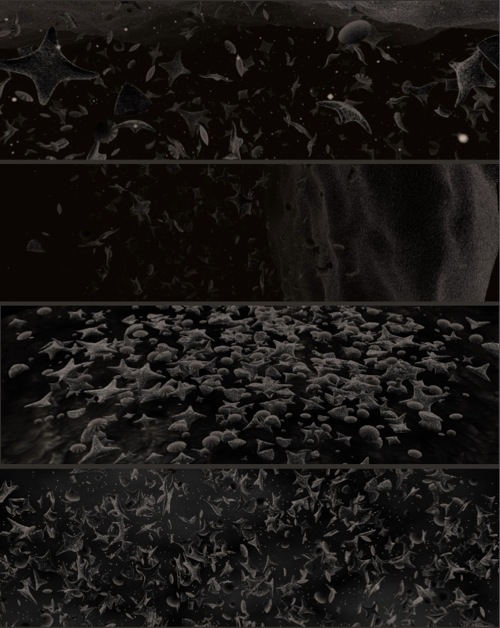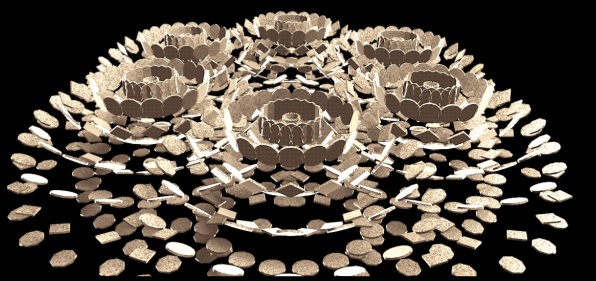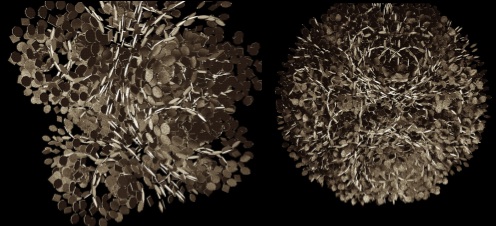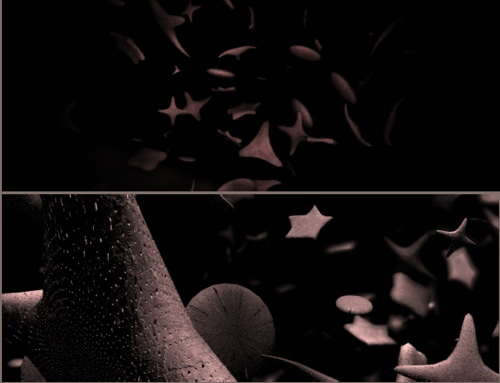Particle Systems
Here I generated an array of diatoms together in the group and added a sound effector that individually positions them within an xyz system. The whole group is then mapped to the general amplitude of the sound rising as the volume rises. This results in the diatoms vibrating to the sound but also flowing all together to it. The diatoms are randomly generated by a particle emitter that also gives them a little rotating push. I also worked on creating an environment for them to exist in further contextualising their presence. To this I used fog that slowly fades in the background creating a feeling of depth and darkness. while turbulent dust particles fly among the diatoms denoting the presence of water. A noisy terrain can be seen in the background, meant to be seen as the ocean bed or perhaps a mere crack in the soil that looks massive in these miniscule scales.
The bottom two examples on the right show particles of diatoms that have been randomly dropped from a certain height and where drawn by a virtual gravity force on the ocean floor that has been programmed with a friction layer so as to absorb their energy and let them subtly settle on top of each other. This is yet another example where the designer programs the actions and lets the computer execute them, which gives that extra element of randomness and organicity.

Kaleidoscopic formations

Here I was looking at different ways of distributing the diatoms besides the random particle mode. I was actually trying to reproduce the kaleidoscopic mandala-like formations of the victorian “diatom art” into 3d. The way I went about it was again with mathematical calculations to create complex structures. I begain with a circle of diatoms that was then multiplied with itself to create a sphere, then projected into a circle that was then multiplied with itself and so on, creating these very elaborate structures. These formations reminded me of planets and solar systems where everything its mapped in relation to another object within the constraints of an ellipse. Although beautiful these have no relation to reality, but then again neither does the victorian diatom art - this is where the human touch comes to play a role. Perhaps there could be a way to add an element of random distortion to these to make them look more organic.

Following my controlled interplanetary experiments I returned back to the randomness and playfulness of particle motion. This time I coded multiple forces onto the particles such as wind, gravity, turbulence, friction and suction and had the computer generate their life-like movements. Using the same light source as the planet experiments before I recorded the slow random movement of these particles and the results can be seen in videos 22-27. In these videos I tried out different setups for cameras, such as still, observing camera, a camera that follows a particular diatom as the wind blows it away, and a camera that sits on top of a diatom following its journey to the fathoms of the sea. Setting up these cameras was not an easy feat and they weren’t as successful either because following an organically moving object involves manually keyframing the position of the camera frame by frame, creating very uneven results.
This is where I decided to seek the help of a programmer to help me code the camera to the particle system making the camera sensitive to the various virtual forces. Together we finally managed to create a code where not only the camera became a particle but also could “jump” from one particle to the next giving wholly different perspectives. In the picture below a spotlight source has been attached to the camera so that as the camera turns in darkness it illuminates a section of the flying diatoms giving a feeling of immersion. The bottom image shows an experiment using distance blur to give the effect of photomacro.